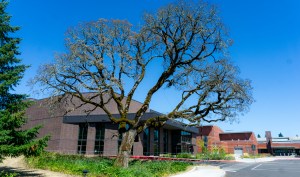Wilsonville city manager draws attention to long-term challenges for general fund
Published 5:12 pm Thursday, May 15, 2025

- A photo of Wilsonville City Hall. (Staff File Photo)
With costs increasing and revenue flatlining, City Manager Bryan Cosgrove said Wilsonville may need to look at alternative funding mechanisms such as a levy or additional fees to keep up with costs to the city’s general fund.
Though he emphasized that the city is not in a financial crisis, Cosgrove voiced concerns about long-term general fund revenues in his message introducing the local government’s proposed annual budget, as well as in a follow-up interview.
The city’s budget committee, which includes the City Council and five citizens at large, held two meetings May 5 and May 13 to discuss the proposed budget before voting to approve it. The next step is for the council to hold a public meeting and vote on a finalized budget. During the May 13 vote, Councilor Adam Cunningham voted no due to concerns about some elements of the city’s transit budget (editor’s note: stay tuned for a follow-up story on the May 13 vote).
Trending
The city’s proposed budget for the 2025-26 fiscal year is $228.9 million, a 20.8% decrease from last year’s total. The decrease continues a trend that began in the 2023-24 fiscal year, when the city’s budget dropped for the first time in a decade. A five-year forecast in the budget document shows a steady downward trend in the city’s general fund’s reserves between the 2026-27 fiscal year and 2029-30 fiscal year after a spike in 2026.
Examples of strategies the City Council could consider moving forward include deciding to reduce the amount of maintenance done in city parks or finding additional revenue sources to ensure the current parks maintenance standards continue to be met.
“In the next 18-24 months, we’re gonna have to have some conversations about additional resources, and/or looking at levels of service — what they are currently versus what our existing resources can withstand,” Cosgrove said in the interview. He wrote in the budget message that, to address the issue, the city must “focus on revenue growth, new sources of revenue, maximizing efficiencies and possibly adjusting service levels to reduce costs.”
While Cosgrove said during a budget meeting on Tuesday, May 5 that room was found in the budget for the City Council’s recently adopted priorities, there were several requests from city staff for capital improvement projects and additional staffing, particularly drawing from the city’s general fund, that could not be fulfilled this year. In an interview, Cosgrove said examples of the declined requests included parks projects and a new employee working in city facilities .
“These were all sound requests. But at this time, the prudent thing to do is to keep our powder dry and keep as many resources available as possible,” Cosgrove said at the budget meeting, noting these projects were necessary and will need to be addressed in the future.
Cosgrove acknowledged at the meeting that the budget is affected by inflation and uncertainties regarding tariffs, which impact costs for city infrastructure, along with the availability of state and federal funding. However, he expressed some optimism, saying that a focus on investing in infrastructure, long-term planning and economic development will help maintain Wilsonville going forward.
Trending
“Those three principles have led the city to the place it is today, and will keep this city in the fine shape it is going forward,” Cosgrove said.
General fund expenses could outpace revenue
The city’s general fund, used to support services such as parks, the library and law enforcement that the city contracts through the Clackamas County Sheriff’s Office, has a $28.7 million operating budget for the upcoming fiscal year — a 5.4% increase from the current year. It heavily relies on revenue from property taxes — totaling an estimated $12.6 million in revenue for the next year — based on the permanent tax rate of approximately $2.50 per $1,000 of assessed value established in 1998. With the exception of new development, growth in assessed value is limited to a 3% annual increase which in turn limits tax revenue.
A graph showing the general fund’s five-year forecast shows the ending fund balance, or the amount left in the fund after all income and expenditures, spiking at more than $13 million in the 2026-27 year, and declining to under $10 million by the 2029-30 year.
Next year, the general fund is expected to have a total of $28.39 million in revenues — an increase from $27.09 million in the current fiscal year — and $32.27 million in expenditures. When asked in the interview about the current fiscal year’s general fund expenditures being higher than expenses, Cosgrove said that this does not directly mean expenses are outpacing revenue because it reflects intentional pulling from the general fund’s reserves.
“If … the requirements (expenses) are more than the resources for any particular year, it’s because we have established reserves in the general fund that we have planned to expend, that exceed the resources for any given year,” Cosgrove said.
Some of the challenges with the general fund include increasing operational and maintenance needs for city parks, rising costs for police contracts (coming to $7 million for the contracted services from the Clackamas County Sheriff’s Office) as well as capital improvement projects pulling from the general fund. Cosgrove also said the city’s growth is slowing down compared to past years. Growth increases the city’s tax base and, in turn, revenue from property taxes.
Another challenge is aging infrastructure. During the May 5 presentation, Wilsonville Finance Director Keith Katko noted that projects such as roof and siding replacements must be done on city buildings as they age, and have been “hitting the general fund” each year.
Options for the city include maintaining the current property tax rate, augmenting the tax rate with a local option levy for public safety funding, implementing a parks utility fee, exploring other revenue sources, seeking cost efficiencies and service reductions, or a combination of these options, Cosgrove stated in the budget message.
“The City must carefully balance the need to sustain high‐quality services with the challenges posed by these competing priorities,” Cosgrove stated in the message. “With aging infrastructure and increasing parks maintenance and operational costs, the City is already exceeding the service levels planned under the 1998 Permanent Rate. Simply put, the City today is vastly different from what it was 27 years ago.”
Councilor Katie Dunwell highlighted Cosgrove’s statements in the budget message, saying they were “very strong statements” that she believes are “well timed.”
“At least for me, I believe the North Star of the city is fiscal responsibility and quality of life, and you directly called out the issues that we may be facing if we don’t continue to make some difficult decisions … as we look at the future of this city from a fiscal standpoint,” Dunwell said.
The overall operating budget for the city’s day-to-day activities is up 1% from last year, at $62.9 million. While there were relatively small increases in the budget for personnel and materials, there is a 41.4% decrease in capital outlay, or large one-time equipment or vehicle expenditures.
What projects are planned in the budget?
There are 100 capital improvement projects planned in the budget, totaling $45.9 million. The five most expensive projects make up 51% of the budget, with the Boeckman Creek Interceptor project being the most expensive at $9.2 million. A loan from the Oregon Department of Environmental Quality will be used to help fund the project.
The second-most expensive project is the build out of the I-5 pedestrian bridge, which is budgeted for $6 million as a match to a federal grant application for $22 million, city engineer Zach Weigel said during the meeting. The project is designed and ready for construction, but if the city’s grant is not approved there is no designated funding source for the project, Weigel said.
Other projects in the top five include improvements to Brown Road at $3 million, the last project to be funded through the Westside Urban Renewal district, a basin expansion at the Waste Water Treatment Plant at $2.7 million and annual street maintenance.
“The total CIP (budget) is down significantly, but the number of projects hasn’t really changed that much,” Weigel said.







